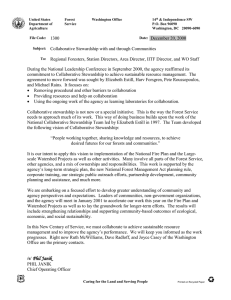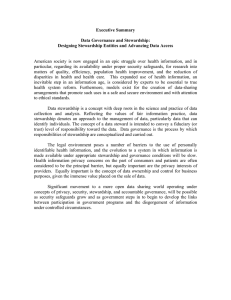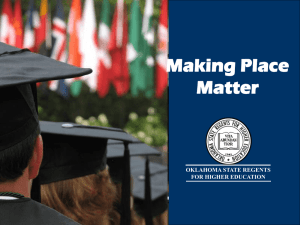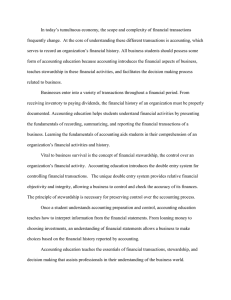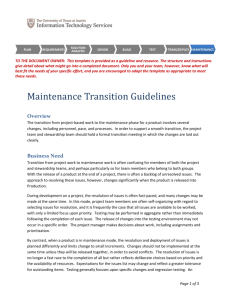Presented by Doug Henton and John Melville Collaborative Economics
advertisement
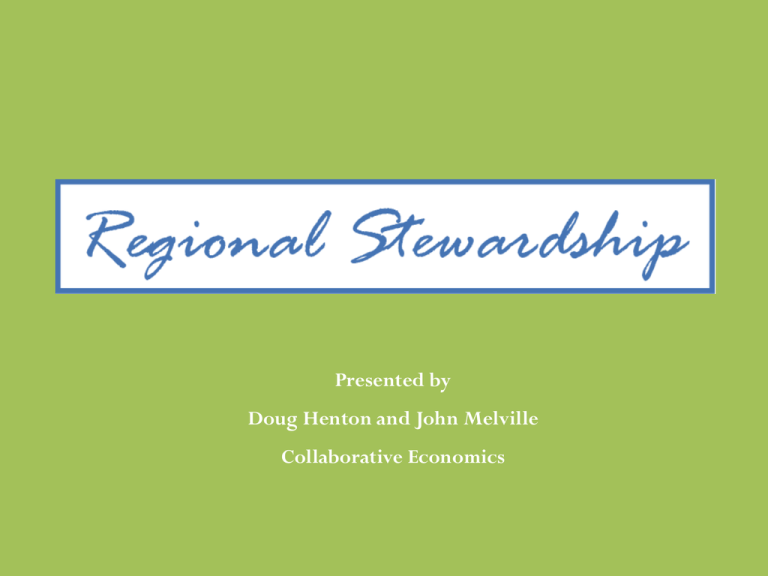
Presented by Doug Henton and John Melville Collaborative Economics SETTING THE STAGE What are the new realities? The realities facing everyone Additional realities facing universities/colleges What are the new requirements? New thinking about leadership New thinking about university/college mission What are the new opportunities? New common ground between institutions and their regions New benefits for all partners in regional collaboration NEW REALITIES: Regions, Universities/Colleges, and Stewardship The Idea-Driven Economy The Proximity Edge The Talent Imperative The Big Regional Sort A New Definition of Success A New Focus on Place-Based Assets The Search for Regional Stewards THE IDEA-DRIVEN ECONOMY Raw material is ideas (the ingredients) Ideas are organized into innovations (recipes) Companies that don’t innovate, die Successful regions institutionalize innovation Innovation requires expertise, interaction, and diversity THE PROXIMITY EDGE Open systems of innovation require many ingredients close by Face-to-face interaction and proximity critical Businesses competing on the basis of innovation locate based on regional knowledge, relationships, and mindset THE TALENT IMPERATIVE Skilled people are the most important resource for innovation Both highly educated populations and specialized concentrations of talent Not just young people, but older workers and immigrants who will be responsible for much of the future labor force growth THE BIG REGIONAL SORT Regions with most college graduates continue to attract more—a growing divide Fast growth does not always equate with gains in college graduates (e.g., Las Vegas) In some regions, universities and community colleges may be one of the few assets to attract knowledge workers and retool older workers and new immigrants A NEW DEFINITION OF SUCCESS Growth in real income per capita, not population or job growth per se Success through wealth comes from innovation, which results in increased productivity and growing prosperity Keys are: education level, science and technology activity, export-oriented industries, entrepreneurial initiative, innovation across industries and sectors, talent strategy, reduction of poverty and inequality A NEW FOCUS ON PLACE-BASED ASSETS Natural environment Distinctive amenities Lifestyle choices (young, baby boomers, immigrants) Innovative place Tolerance, inclusiveness Speed NEW REALITIES MEAN NEW RESPONSES ARE REQUIRED America’s Citistates Most complex challenges today are regional in scale. Traditional business, government and civic responses are not adequate Boundary-crossing is now required Few know how to engage in this kind of regional civic leadership CHALLENGE OF REGIONAL COMPLEXITY Four regional, often distinct, conversations today: INNOVATIVE ECONOMY how to succeed in the innovation economy and ensure everyone participates LIVABLE COMMUNITY how to create communities where people want to live SOCIAL INCLUSION how to ensure inclusive and equitable communities COLLABORATIVE GOVERNANCE How to form public-private alliances to tackle complex challenges FRAMEWORK FOR REGIONAL STEWARDSHIP THE SEARCH FOR REGIONAL STEWARDS Complex challenges overwhelm traditional approaches and systems Leaders are often fragmented, unaware of one another, or focused too narrowly Stewards are emerging at the center of four conversations, forging new approaches Universities and community colleges are logical stewards of place A NEW LEADERSHIP MODEL Regional Stewardship: commitment to place Traditional Leadership: commitment to an issue/cause Stewards understand the interdependence between the economy, society, and environment Regional stewardship is both an individual and a regional capacity NEW EXPECATIONS New expectations for university/college contributions to the region—roles in all four conversations New expectations that universities/colleges step forward as “stewards of place” as they are uniquely situated—embedded—with a sense of place UNIVERSITIES EMERGING AS REGIONAL STEWARDS FROM TO Teaching Learning Research Innovation Service Shared Leadership TEACHING TO LEARNING FROM TO Classroom Classroom w/o walls Teaching inputs Educational outcomes One-way content delivery Two-way exchange Preparation of next generation Continuous preparation of all generations RESEARCH TO INNOVATION FROM Idea generation Individual inventions Single discipline focus Higher education institution-centered work TO Idea application Collaborative innovations Interdisciplinary focus Regional collaborations SERVICE TO SHARED LEADERSHIP FROM TO Episodic, short-term involvement Sustained, long-term involvement Tactical, individual contributions Strategic, institutional commitment Issue/cause focus Focus on community/ region well-being Accountability for services rendered Shared responsibility for results AN ERA OF OPPORTUNITY? Talent, innovation, and shared leadership have never been so important Universities and community colleges are a critical asset for succeeding in this new world Neither universities/colleges nor other regional leaders can do it alone, without crossing boundaries Regional stewardship offers a path forward 4 STEP PROCESS STEP 1: Establish Regional Context Identify and diagnose the region, paying particular attention to the four conversations (innovative economy, livable community, inclusive society, collaborative governance) Identify and order stewardship priorities for the region Identify primary regional resources and capacity, focusing on top stewardship priorities. STEP 2: Assess University-System-State Resources Identify university/college resources and capacities that are currently applied (or could be applied) to top regional stewardship priorities. Assess policy/practice environments (campus-systemstate) that help or hinder the institution’s regional application of resources and capacity to stewardship priorities. STEP 3: Develop Goals and Success Measures Identify target areas for stewardship initiatives and for institutionalization of top stewardship priorities. Establish success measures for top regional stewardship priorities. STEP 4: Develop Stewardship Roadmap KEY EXPECTATIONS Effort must be simultaneously region and institution centered, rather than one or the other Effort is a strategic conversation, not a program or budget discussion Effort must focus on immediate actions and policy changes that have both short-term results and longterm impacts THE OKLAHOMA MPM SEMINAR: SIMULATION OF FULL PROCESS 4 Step Process 4 Meetings with “homework” and committee work over one year Adapted 3 Session Process 3 Sessions with debriefing time at lunch and at end of the day Regional-Institution teams of 25-75 people Regional-Institution teams up to 12 people “Prototype Process” “Test Drive” STEP 1: ESTABLISH REGIONAL CONTEXT REGIONAL CHALLENGES INNOVATIVE ECONOMY Preparing people and places to succeed LIVABLE COMMUNITY Preserving and creating places to live and work SOCIAL INCLUSION Ensuring that everyone participates and shares responsibility COLLABORATIVE GOVERNANCE Finding creative ways to govern REGIONAL ASSETS REGIONAL OPPORTUNITIES REGIONAL PRIORITIES EXAMPLES OF REGIONAL CHALLENGES REGIONAL CHALLENGES INNOVATIVE ECONOMY Preparing people and places to succeed INNOVATIVE ECONOMY—primarily economically-driven concerns such as industry restructuring, job loss, entrepreneurship, commercialization of new technologies, climate for innovation LIVABLE COMMUNITY Preserving and creating places to live and work LIVABLE COMMUNITY—primarily quality-of-life driven concerns such as environmental quality, urban and neighborhood revitalization, land use, transportation congestion, housing, amenities SOCIAL INCLUSION Ensuring that everyone participates and shares responsibility COLLABORATIVE GOVERNANCE Finding creative ways to govern SOCIAL INCLUSION - primarily socially-driven concerns such as poverty, educational preparation, employment opportunity, community health, civic participation COLLABORATIVE GOVERNANCE - primarily problem-solving concerns such as the need for regional alliances of local jurisdictions, local/state/federal collaboration, and public-private partnerships to address complex regional challenges STEP 1: ESTABLISH REGIONAL CONTEXT REGIONAL CHALLENGES INNOVATIVE ECONOMY Preparing people and places to succeed LIVABLE COMMUNITY Preserving and creating places to live and work SOCIAL INCLUSION Ensuring that everyone participates and shares responsibility COLLABORATIVE GOVERNANCE Finding creative ways to govern REGIONAL ASSETS EXAMPLES OF ASSETS REGIONAL ASSETS—major regional collaborative initiatives, key public and/or private investments, major institutions that do or could address the challenge INSTITUTION ASSETS— leadership, expertise, major internal and externally focused initiatives, key investments/incentives/policies STEP 1: ESTABLISH REGIONAL CONTEXT REGIONAL CHALLENGES INNOVATIVE ECONOMY Preparing people and places to succeed LIVABLE COMMUNITY Preserving and creating places to live and work SOCIAL INCLUSION Ensuring that everyone participates and shares responsibility COLLABORATIVE GOVERNANCE Finding creative ways to govern REGIONAL ASSETS REGIONAL OPPORTUNITIES REGIONAL PRIORITIES STEP 2: ASSESS INSTITUTION/SYSTEM/STATE STEWARDSHIP CAPACITIES (ON YOUR OWN) HOW IS THE INSTITUTION REGIONAL PRIORITIES CURRENTLY ENGAGED IN THESE PRIORITIES? HOW ELSE COULD IT BE ENGAGED? WHAT CHANGES ARE NEEDED FOR STRENGTHENING INSTITUTION ENGAGEMENT? STEP 3: DEVELOP GOALS & MEASURES (WE WILL CONDENSE TO REGIONAL OUTCOMES TODAY) REGIONAL PRIORITIES REGIONAL GOALS REGIONAL MEASURES STEP 4: DEVELOP REGIONAL STEWARDSHIP ROADMAP Oklahoma MPM: Past, Present, Future Presidents’ Orientation (June) Determine Regions, Choose Facilitators, and Forge Agreements to Work Together Among Higher Education Institutions in the Same Region (June-September) Facilitator Briefing Book and Training Session (October 1) Assemble Regional Team to Attend MPM Seminar (Team to include up to 12 institutional, business, and community partners) (September-October) MPM Seminar (October 29)
